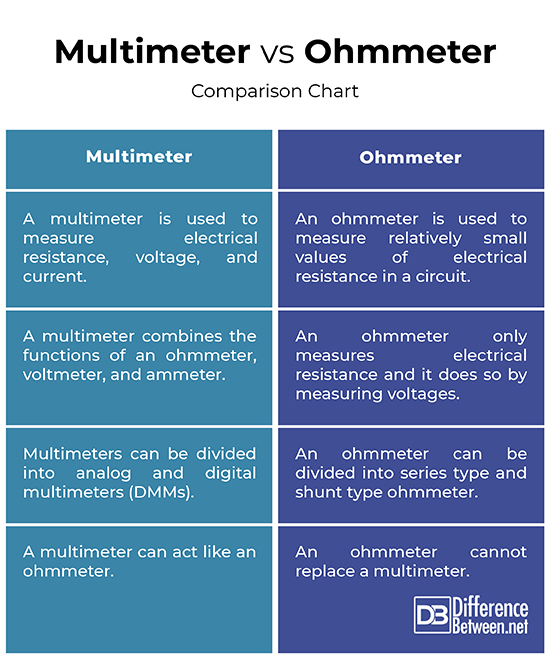Difference Between Multimeter and Ohmmeter
Both are common handheld instruments used by electricians to measure electrical resistance in circuits. There’s been a long-standing dispute between the instruments being used interchangeably and people are often confused if one can replace the other. But each one of the instrument has unique traits and uses. Before we dive right into our topic of interest, let’s try to understand the basics of these instruments and how they work first. Let’s get started.

What is a Multimeter?
Multimeter is one of the most commonly used measurement devices used to measure electrical resistance, voltage (AC or DC), and current (AC or DC). More advanced multimeters can be used to measure other parameters such as capacitance, temperature, frequency, transistor gain, and voltage drop of diodes. A multimeter is often called a Volt-Ohm-Milliammeter because it essentially combines with functions of a voltmeter, ohmmeter, and ammeter. Before taking a reading, you must set the correct range and then connect the test probes to the device or circuit to be measured.
A multimeter could be divided into two standard types: analog multimeter and digital multimeter (DMM). An analog multimeter, as the name suggests, makes use of a moving pointer and a scale to show the value. A digital multimeter, just like a digital wristwatch, has no moving parts, but rather a digital display where measurement readouts are displayed. Digital multimeters are convenient and easy to read with a little or no chance of read error. The more expensive ones come with this auto-ranging feature which automatically sets the test range.

What is an Ohmmeter?
An ohmmeter is a simple test instrument that is used to measure electrical resistance. It is a portable electronic measurement device used to measure relatively small values of electrical resistance in a circuit. The measuring unit of resistance is ohm. Resistance is one of the fundamental attributes of an electrical circuit that measures the hindrance to the flow of current through an electrical circuit. An ohmmeter gives an approximate value of resistance. In addition, an ohmmeter can give a rough check on the condition of capacitors.
It is one of the basic test instruments along with a voltmeter and an ammeter. Please note that an ohmmeter forms circuits by itself, so it cannot be used within an assembled circuit. To measure the resistance in a circuit, you need to disconnect the power first before taking the reading. Most ohmmeters are designed to cover a wide range of values of resistance from very low to very high. A standard ohmmeter consists of a current meter, a battery source, and some form of current-limiting resistor. The battery supplies the necessary DC voltage.
Difference between Multimeter and Ohmmeter
Function
Both are portable measuring instruments used for measuring electrical resistance in electrical circuits or networks. An ohmmeter is a basic testing tool that is used to measure relatively small values of electrical resistance in a circuit. In addition, it gives a rough check on the condition of capacitors. A multimeter is a multi-functional test instrument that is used to measure electrical resistance, voltage (AC or DC), and current (AC or DC). A multimeter combines the functions of multiple devices, such as an ohmmeter, voltmeter, and ammeter.
Working
Digital multimeters (DMMs) are the most common type of multimeters available on the market these days. It consists of a selector switch to choose from the electrical characteristics to measure, an analog to digital converter, and a digital display to show the values. A small current is injected into the unknown resistor from a current source and then the voltage drop across the points is measured. The resistance is then calculated using the Ohm’s Law and displayed on the screen.
When the current flows through the circuit, the pointer deflects in the meter. The current is provided by a battery in the device. A milliammeter is connected in series with the circuit and converts the reading into resistance using the Ohm’s Law. An analog ohmmeter consists of a needle and two test leads. When current flows through the circuit, the meter either deflects to the left or to the right. Left means high resistance or low current and right means low resistance or high current.
Multimeter vs. Ohmmeter: Comparison Chart

Summary
While both are handheld test instruments used for measuring electrical resistance in a circuit, a multimeter is a multi-purpose diagnosing tool that can also be used as a voltmeter, ohmmeter, and an ammeter. It can be used for measuring multiple electrical properties, including electrical resistance, voltage, and current. A multimeter can be used to measure other parameters such as capacitance, temperature, frequency, transistor gain, and voltage drop of diodes. An ohmmeter is a portable electronic device that can be used to measure relatively small values of electrical resistance.
Is a multimeter the same as an ohmmeter?
An ohmmeter is a common testing tool used to measure resistance. While a multimeter can be used to measure resistance, it can also measure other electrical properties such as voltage, current, capacitance, temperature, frequency, transistor gain, etc.
What is the difference of voltmeter and ohmmeter?
Voltmeter is an electronic device used to measure voltage across a circuit, while an ohmmeter is used to measure small values of electrical resistance and other high-resistance values.
What is the other name of ohmmeter?
An ohmmeter is also called an ohm meter or microohmmeter.
- Difference Between Caucus and Primary - June 18, 2024
- Difference Between PPO and POS - May 30, 2024
- Difference Between RFID and NFC - May 28, 2024
Search DifferenceBetween.net :
Leave a Response
References :
[0]Pickering, Martin. How to Use a Multimeter. North Carolina, United States: Lulu Press, 2016. Print
[1]Asadi, Farzin and Kei Eguchi. Electronic Measurements: A Practical Approach. California, United States: Morgan & Claypool Publishers, 2021. Print
[2]Kishore, K. Lal. Electronic Measurements and Instrumentation. Noida, India: Pearson Education India, 2009. Print
